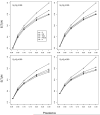Informative Dorfman screening
- PMID: 21762119
- PMCID: PMC3197971
- DOI: 10.1111/j.1541-0420.2011.01644.x
Informative Dorfman screening
Abstract
Since the early 1940s, group testing (pooled testing) has been used to reduce costs in a variety of applications, including infectious disease screening, drug discovery, and genetics. In such applications, the goal is often to classify individuals as positive or negative using initial group testing results and the subsequent process of decoding of positive pools. Many decoding algorithms have been proposed, but most fail to acknowledge, and to further exploit, the heterogeneous nature of the individuals being screened. In this article, we use individuals' risk probabilities to formulate new informative decoding algorithms that implement Dorfman retesting in a heterogeneous population. We introduce the concept of "thresholding" to classify individuals as "high" or "low risk," so that separate, risk-specific algorithms may be used, while simultaneously identifying pool sizes that minimize the expected number of tests. When compared to competing algorithms which treat the population as homogeneous, we show that significant gains in testing efficiency can be realized with virtually no loss in screening accuracy. An important additional benefit is that our new procedures are easy to implement. We apply our methods to chlamydia and gonorrhea data collected recently in Nebraska as part of the Infertility Prevention Project.
© 2011, The International Biometric Society.
Figures


Comment in
-
Rejoinder to "Reader reaction: A note on the evaluation of group testing algorithms in the presence of misclassification".Biometrics. 2016 Mar;72(1):303-4. doi: 10.1111/biom.12386. Epub 2015 Sep 10. Biometrics. 2016. PMID: 26355793 No abstract available.
-
Reader reaction: A note on the evaluation of group testing algorithms in the presence of misclassification.Biometrics. 2016 Mar;72(1):299-302. doi: 10.1111/biom.12385. Epub 2015 Sep 22. Biometrics. 2016. PMID: 26393800
References
-
- Alter H. Emerging, re-emerging, and submerging infectious threats to the blood supply. Vox Sanguinis. 2004;87:56–61. - PubMed
-
- Butylkina R, Juseviciute V, Kasparaviciene G, Vagoras A, Pagirskas E, Unemo M, Domeika M. Pooling of urine specimens allows accurate and cost-effective genetic detection of Chlamydia Trachomatis in Lithuania and other low-resource countries. Scandinavian Journal of Infectious Diseases. 2007;39:209–212. - PubMed
-
- Centers for Disease Control . Trends in reportable sexually transmitted diseases in the United States, 2007. 2009. Available at http://www.cdc.gov/STD/stats07/trends.htm.
-
- Dodd R, Notari E, Stramer S. Current prevalence and incidence of infectious disease markers and estimated window-period risk in the American Red Cross donor population. Transfusion. 2002;42:975–979. - PubMed
Publication types
MeSH terms
Grants and funding
LinkOut - more resources
Full Text Sources
Other Literature Sources
Medical

